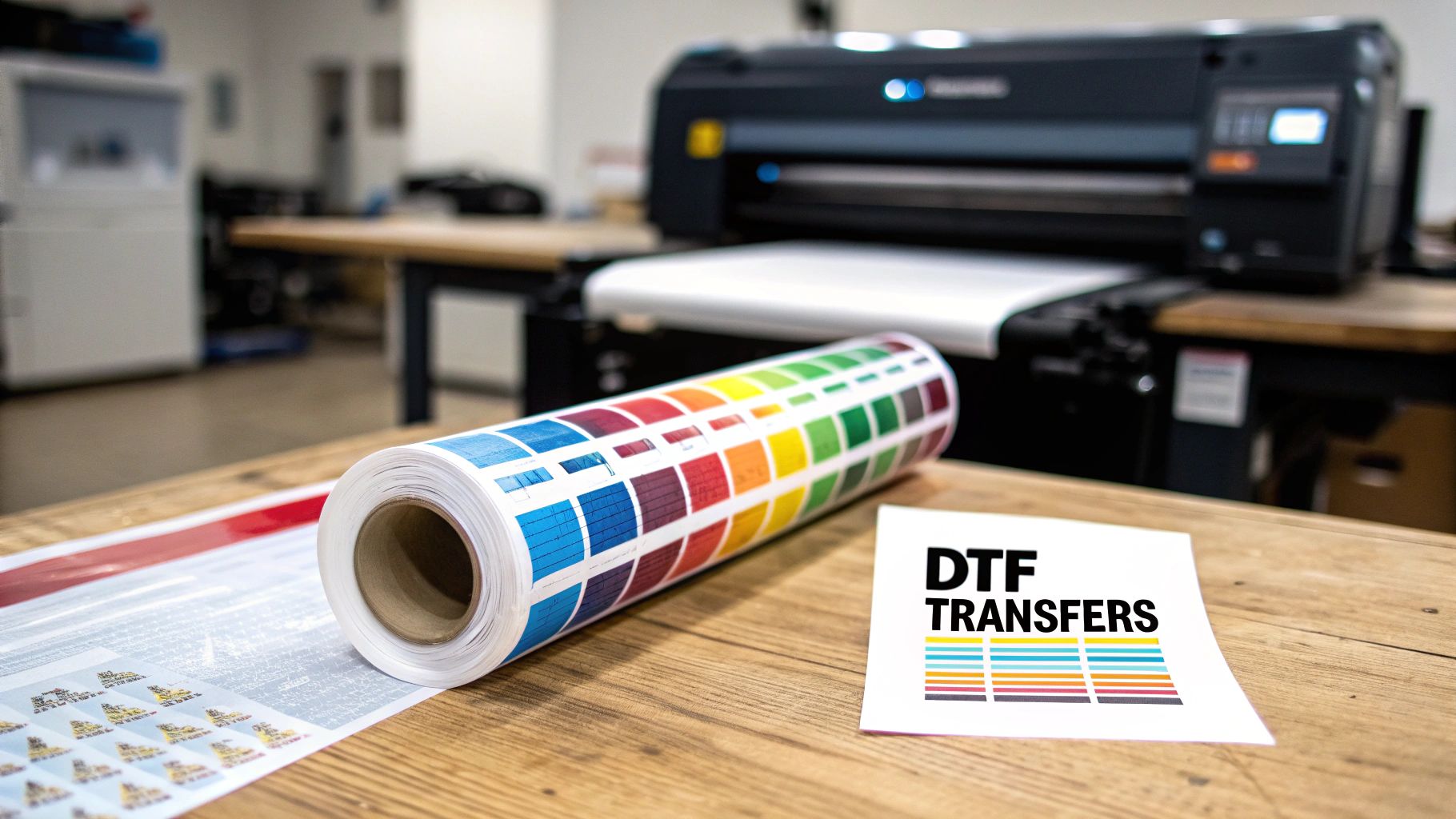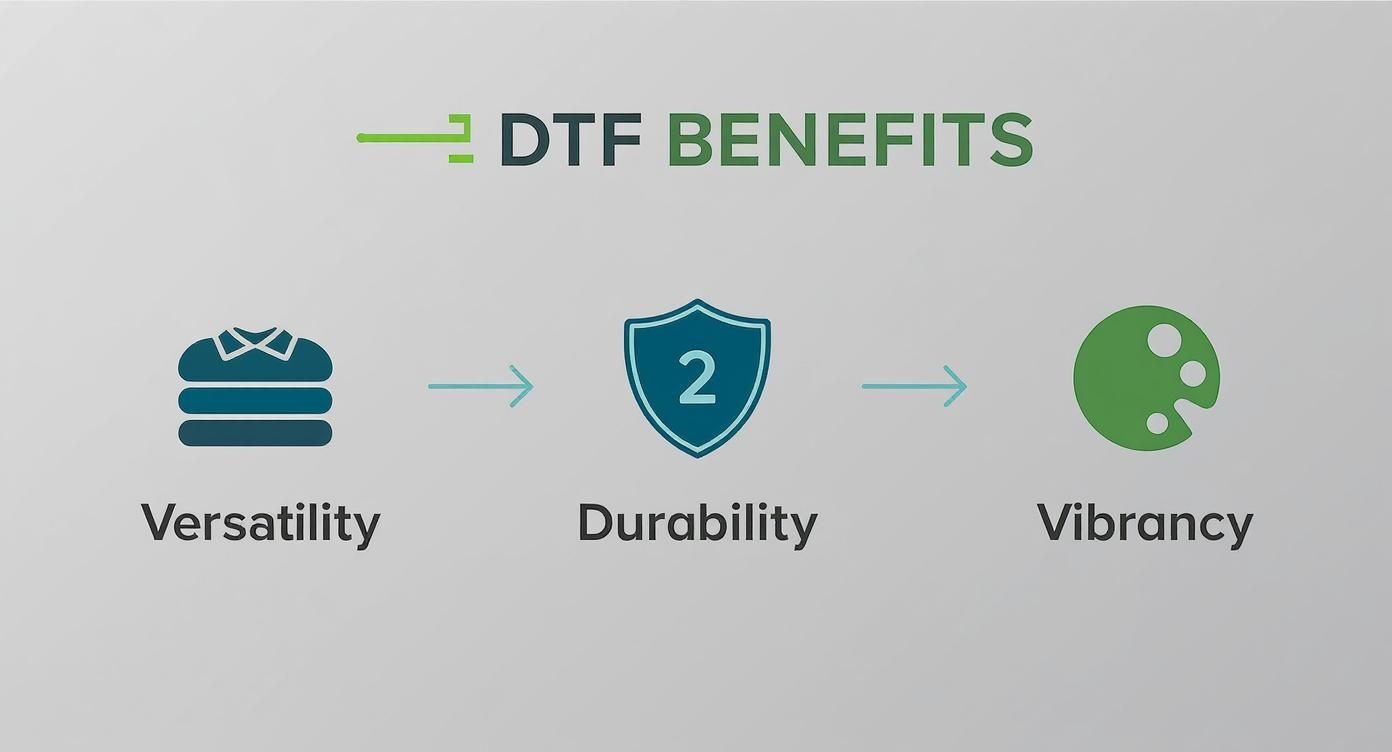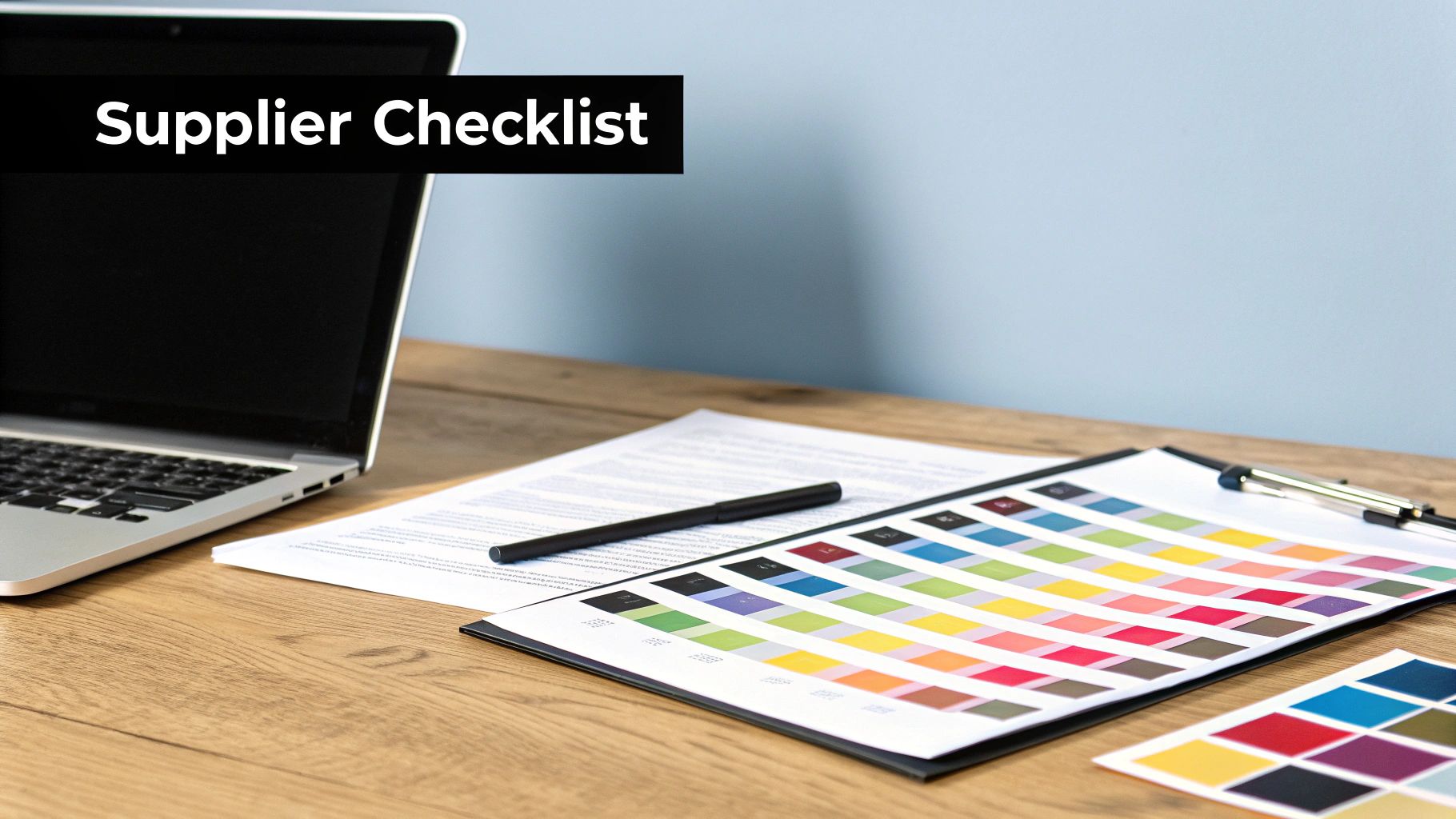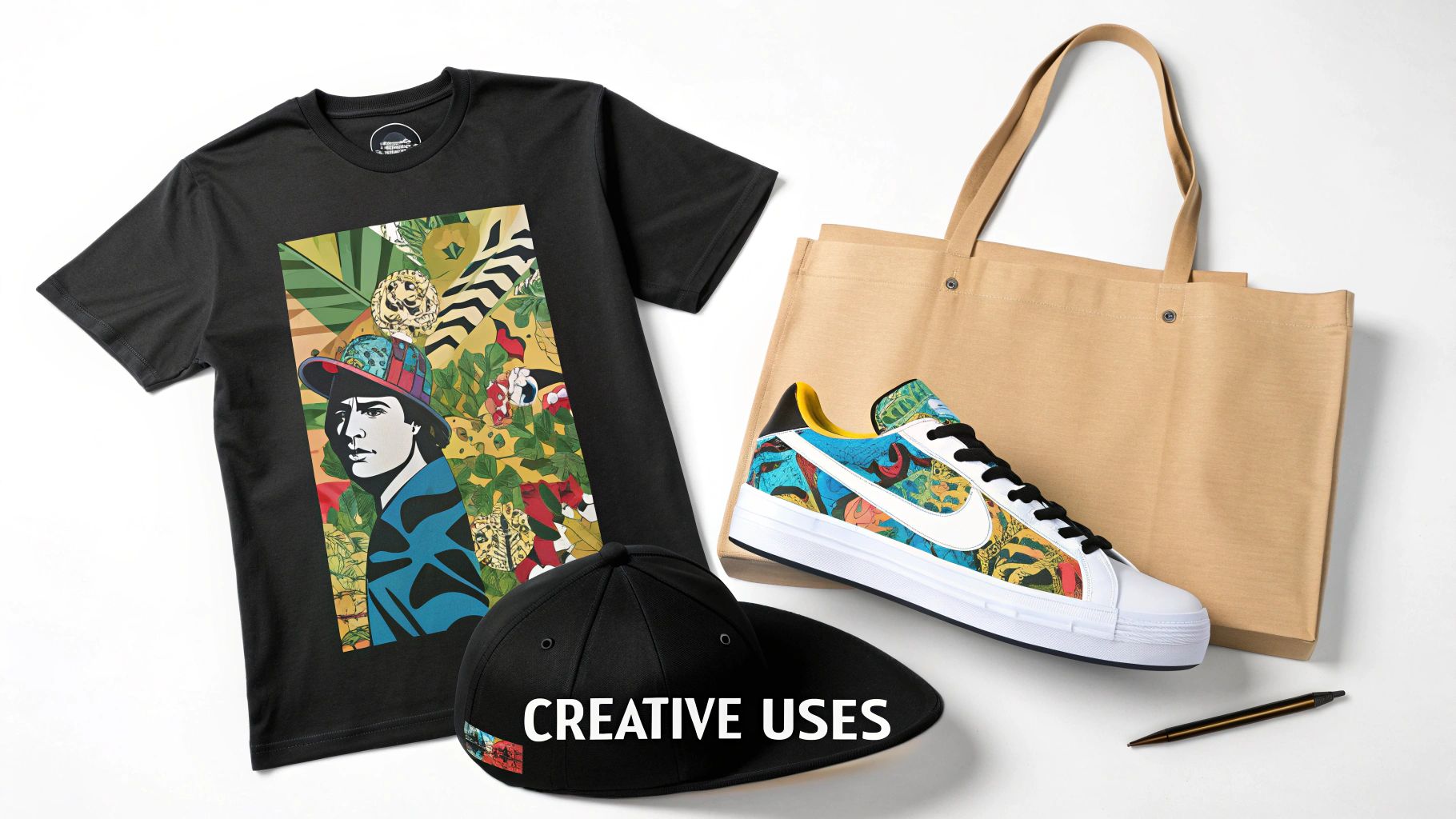
Finding DTF Transfers for Sale A UK Buyer's Guide
Share
On the hunt for DTF transfers for sale? You've landed on one of the most exciting and versatile ways to print custom apparel today. Think of a DTF transfer as a high-tech, ready-to-press decal for almost any fabric imaginable. It’s a method that lets you take brilliant, full-colour designs from a screen and get them onto clothing using a simple heat press.
What Exactly Are DTF Transfers?

Let’s say you’ve got a really detailed, multi-coloured design you want to put on a dark hoodie. In the past, this was a real headache, often involving complicated screen setups or printing methods that just didn't look right on dark fabrics.
Direct-to-Film (DTF) printing completely changes the game. Your digital design is printed onto a special film, a fine adhesive powder is applied to the back, and it's then cured with heat.
What you're left with is a durable, flexible "transfer" that’s ready to be heat-pressed onto a garment. It's like the ultimate upgrade to those old-school iron-ons, but with professional quality, incredible detail, and a soft feel that moves with the fabric. If you want to dive deeper, we have a full guide on what DTF stands for and the tech behind it.
Why Is This Method So Popular?
The massive surge in businesses looking for DTF transfers for sale isn't just hype; it’s down to some very real advantages. DTF printing solves a lot of the common problems and limitations that creators, small businesses, and even big brands have faced with other printing methods for years.
Here’s why so many people are making the switch:
- Fabric Versatility: This is a huge one. DTF works beautifully on a massive range of materials, including cotton, polyester, nylon, and all sorts of blends. That's a game-changer compared to something like DTG (Direct-to-Garment), which really only shines on 100% cotton.
- Vibrant Colours on Any Fabric: It’s brilliant at producing rich, opaque colours on both light and dark garments without needing any messy pre-treatment. A base layer of white ink is printed first, which makes sure your designs pop, no matter what colour the fabric is.
- Exceptional Durability: When they’re applied correctly, these transfers are incredibly tough. They can handle dozens of washes without cracking, peeling, or fading away, all while staying soft and flexible on the shirt.
DTF technology makes high-quality, professional customisation accessible and affordable for everyone. It gets rid of complicated setups and allows for small-batch production, empowering creators to produce amazing apparel on demand.
The numbers back it up, too. In the UK, the DTF printing market was worth a massive USD 192.2 million in 2025 and is expected to grow to USD 249.0 million by 2030, all thanks to the booming demand for personalised fashion. This growth shows just how many businesses are turning to DTF to get the job done right.
The Real Benefits of Using DTF Transfers
When you're looking for DTF transfers for sale, you're buying more than just ink on a film. You're investing in a ridiculously versatile tool for your business, one that solves a lot of the usual headaches that come with custom apparel and opens up some exciting new doors.
Think about it. One of the biggest wins is just how flexible the whole thing is. Imagine printing the exact same vibrant, super-detailed design on a 100% cotton tee, then a polyester sports jersey, a nylon work jacket, and even a canvas tote bag. DTF doesn't get picky about fabrics, giving you the freedom to expand your product line-up without having to switch up your entire printing process.
Unmatched Durability and Feel
Let's be honest, customers want clothes that not only look brilliant on day one but also hold up over time. DTF transfers are engineered to deliver exactly that, built to withstand 50 or more washes without cracking, peeling, or fading into a shadow of their former selves.
The ink actually bonds with the fabric fibres, creating a finish that feels soft and flexible. It's not like that old, stiff vinyl that sits on top of a t-shirt like a plastic shield. A properly applied DTF transfer moves with the garment, making your designs comfortable to wear and keeping that premium feel that brings people back for more. This resilience makes them a perfect match for everything from trendy streetwear to rugged workwear that needs to take a beating.
Stunning Vibrancy and Detail
This is where DTF technology really shows off. It's fantastic at reproducing complex, photo-realistic images and tiny, intricate details with amazing clarity. Because the design is printed onto the film first, it can capture fine lines, smooth gradients, and a practically limitless range of colours.
A white ink base layer is automatically printed behind your design, which acts a bit like a primer on a canvas. This is the secret to making sure your colours pop with bold, opaque coverage, even when you press them onto the darkest black or navy fabrics.
This whole process ensures your final product looks exactly how you designed it on screen. For a closer look at how it all comes together, our guide on DTF heat transfers breaks down the steps and offers some helpful tips.
Economic Sense for Every Business
Now for the part that really matters to small businesses and start-ups: the cost. Traditional methods like screen printing can be a real barrier, with hefty setup fees for every single colour and massive minimum order quantities. DTF completely sidesteps these problems.
The financial advantages are pretty clear:
- No Minimum Orders: Need one transfer? Or a thousand? No problem. This is perfect for testing out new designs, handling one-off custom jobs, or dropping limited edition runs without any financial risk.
- No Colour Fees: A design with two colours costs exactly the same to print as one with twenty. This frees you up to get creative without worrying about a complex design sending your costs through the roof.
This straightforward approach levels the playing field, allowing businesses of any size to compete, manage their stock smartly, and react to new trends without tying up a load of cash in bulk orders.
DTF Transfers Compared to Other Printing Methods
Choosing the right printing method can feel overwhelming, with each having its own pros and cons. To make it a bit clearer, here’s a quick breakdown of how DTF stacks up against two other popular methods: Screen Printing and Direct-to-Garment (DTG).
| Feature | DTF Transfers | Screen Printing | Direct-to-Garment (DTG) |
|---|---|---|---|
| Best For | Versatility; vibrant, full-colour designs on any fabric. | Large batches (100+) with simple, limited-colour designs. | Detailed, full-colour prints on 100% cotton garments. |
| Fabric Compatibility | Excellent. Works on cotton, polyester, blends, nylon, etc. | Good, but inks need to be changed for different fabric types. | Limited. Best on 100% cotton; struggles with synthetics. |
| Feel on Garment | Soft, flexible, and moves with the fabric. | Can be thick and heavy, especially with many colours. | Very soft, as ink soaks directly into the fibres. |
| Durability | Very high. Rated for 50+ washes without cracking or fading. | Excellent. Very durable and long-lasting. | Good, but can fade faster than DTF or screen printing. |
| Colour Complexity | Unlimited colours and gradients at no extra cost. | Expensive. Each colour adds a new screen and setup fee. | Unlimited colours, great for photos and gradients. |
| Minimum Order | None. You can order just one. | High. Economical only for large bulk orders. | None. Good for one-offs and small runs. |
| Setup Costs | None. | High. Screens must be created for each colour in the design. | Minimal. Just requires pre-treating the garment. |
Ultimately, while methods like screen printing are powerhouses for huge, simple runs, and DTG is fantastic for one-off cotton prints, DTF really shines with its unmatched versatility and cost-effective model for complex designs on literally any fabric.
How to Apply DTF Transfers for Perfect Results
Turning that ready-to-press transfer into a professional, retail-quality garment is a surprisingly simple process, but the magic is in the details. With the right technique, you can get a flawless finish every single time, making sure your designs look vibrant, feel great, and are tough enough to last.
The secret to success comes down to three things: temperature, time, and pressure. Getting this trio just right is what separates a transfer that lasts for years from one that peels after the first wash. Think of it like baking a cake—even with the best ingredients, the wrong oven settings will spell disaster.
Preparing for a Perfect Press
Before you even think about switching on your heat press, a little prep work makes all the difference. Start by pre-pressing your garment for 5-10 seconds. This might seem like a small step, but it's crucial for removing any hidden moisture and smoothing out wrinkles. It gives you a perfectly flat, dry canvas for the transfer to stick to.
Next, carefully position your DTF transfer on the garment. Once you're happy with how it looks, cover it with a Teflon sheet or a piece of parchment paper. This protective layer is your best friend—it stops the scorching hot platen from touching the transfer film directly, ensuring heat is spread evenly without any mishaps.
Heat Press Settings and Application
While the perfect settings can change a bit depending on the fabric, a solid starting point for most cotton and polyester blends is a temperature of 150-165°C (300-330°F). You’ll want to apply firm, even pressure for about 10-15 seconds.
Pro Tip: Don't be shy with the pressure. You're trying to physically embed the adhesive into the fabric's fibres. If your press doesn't have a fancy pressure gauge, just aim for a setting that takes a good bit of effort to lock down.
Once the timer goes off, what you do next depends entirely on whether you have a hot or cold peel transfer. Your supplier will tell you which one you've got, and it’s an instruction you absolutely must follow.
- Hot Peel: You’ll pull the film off immediately after the press opens, while everything is still piping hot.
- Cold Peel: You need to be patient here. Let the garment and transfer cool down completely to room temperature before even thinking about peeling the film away. Rushing a cold peel is one of the most common ways to ruin a good application.
For the finishing touch, do one final press for 5-7 seconds with the Teflon sheet placed over the design. This final step really locks everything in, boosts durability, and gives the print a softer, more integrated feel. Understanding these little details is what makes all the difference when you're working with DTF transfers ready to press, ensuring you get fantastic results every time.
This infographic breaks down the key benefits that make this whole process worth it, focusing on versatility, durability, and vibrancy.
As you can see, a successful application is what truly unlocks the potential of DTF technology for any clothing business.
Choosing The Right UK DTF Transfer Supplier

Finding a dependable supplier is the absolute bedrock of a successful apparel business. When you're looking for DTF transfers for sale, you aren't just buying a product. You're building a partnership that will have a direct impact on the quality of your finished garments and, ultimately, your brand's reputation.
A great supplier is worth their weight in gold, delivering consistent, high-quality prints every time. A bad one? They can be a fast track to faded colours, peeling designs, and a wave of unhappy customers.
The UK is a major player in Europe's booming print scene. To give you an idea of the scale, the global DTF printing market was valued at USD 2.72 billion in 2024 and is on track to hit USD 3.92 billion by 2030. That's some serious growth, all fuelled by the demand for custom gear. You can dig deeper into these global DTF printing market trends on Grand View Research. Choosing the right partner is your ticket to getting a piece of that action.
Vetting Potential Suppliers
Before you commit your hard-earned cash, you need to do your homework. The first and most obvious thing to check is the print quality itself. Ask for samples and look for rich, accurate colours and sharp, crisp details. A top-tier transfer should feel soft and flexible when you press it—not thick or like a piece of plastic stuck on a shirt.
But it's not just about the physical product. Their customer service and policies are just as crucial. A reliable partner will be open about how they work and clear in their communication.
Think of your supplier as an extension of your own production line. Their reliability directly affects your ability to meet deadlines and keep your own customers happy.
To make a smart choice, you need to ask the right questions. Don't be shy about reaching out to get clarity before you even think about placing an order.
An Essential Checklist For Choosing A Partner
Here are a few critical questions you should be asking any potential UK supplier offering DTF transfers for sale:
- Turnaround Times: How quickly can they actually print and ship your orders? This is make-or-break for managing your own production flow.
- Shipping Policies: Do they offer tracked shipping as standard? What are the costs, and do they have an express option if you're in a tight spot?
- Artwork Requirements: What file types (like PNG or AI) and resolution (300 DPI is standard) do they need? Getting this right from the start saves a lot of headaches.
- Sample Packs: Do they offer sample packs? Honestly, this is the single best way to test their quality firsthand before you go all in.
Ordering a sample pack lets you see the vibrancy, feel the texture, and even do a wash test to check durability. It’s an invaluable step. Taking the time to properly vet suppliers will help you build a solid relationship and ensure every product you sell is something you can be proud of.
For those wanting to source locally, our guide on finding DTF transfers near me has some extra tips for finding the best options in your area.
Creative Ways to Use DTF Transfers

Once you realise just how versatile DTF transfers are, a whole world of creative possibilities opens up far beyond the classic cotton t-shirt. Because they can stick to almost any fabric, you can put a custom design on products that other printing methods simply can't touch.
Think about a local café wanting branded aprons for their baristas, or a construction company needing tough, high-visibility logos on nylon work jackets. DTF makes this happen. It gives businesses the flexibility to create a cohesive, professional look across all their gear, from staff uniforms to promotional merchandise. This isn't just about looking good; it's about unlocking new revenue streams and branding opportunities.
Beyond Standard Apparel
The real fun starts when you think outside the box. Artists can launch their own lines of custom-decorated tote bags, and sports teams can get unique kits with names and numbers on polyester jerseys. The process works just as well on accessories as it does on clothing.
Consider these exciting applications:
- Headwear: Print detailed, multi-coloured logos on trucker hats, beanies, and caps without worrying about awkward shapes or tricky materials.
- Footwear: Customise canvas shoes with unique patterns or graphics, turning them into one-of-a-kind wearable art.
- Tough Materials: Apply intricate designs to rugged items like denim jackets or canvas backpacks—products that are notoriously difficult to print on.
- Home Goods: Even items like custom cushion covers or fabric pennants for events can be decorated with surprising ease.
This level of adaptability is what's driving so much growth across the European print market. The UK is a huge part of this trend, but we're seeing similar progress in other major players like Germany and France. The widespread adoption of this kind of printing tech is a big reason for the expansion. If you're interested in the numbers, you can discover detailed market forecasts on Research and Markets and see the regional dynamics for yourself.
Tapping into Niche Markets
This versatility allows you to get really specific and cater to unique audiences. For instance, a small gym could create branded performance wear for its members, or a pet accessory brand could offer personalised bandanas for dogs. The possibilities are endless.
When you have DTF transfers for sale, you're not just selling a product. You're offering a solution that helps people bring their unique ideas to life on virtually any fabric surface.
By exploring these creative avenues, you can tap into underserved markets and build a diverse product catalogue that really stands out from the crowd. The only real limit is your imagination.
Got Questions About DTF? We've Got Answers
Stepping into the world of custom printing can feel like learning a new language, especially when you're trying to find the best DTF transfers for sale. We get it. That's why we've put together this section to tackle the most common questions we hear every day. Getting these details straight will help you order with confidence and get brilliant results on every project.
We'll cover everything from how long your designs will last and the right way to apply them, to the kind of artwork files you need to send over. Our aim is to make the whole process crystal clear, so you have everything you need to create professional-quality gear that looks amazing and stands the test of time.
How Long Do DTF Transfers Last on Clothing?
This is probably the number one question we get, and for good reason! Durability is everything. The brilliant news is that a high-quality DTF transfer, when applied correctly, is built to last for the entire life of the garment.
Seriously. They are engineered to handle 50 or more washes without cracking, peeling, or fading into a shadow of their former selves. The secret to this incredible lifespan comes down to two things: the quality of the transfer itself and making sure you follow the application instructions to the letter. A little bit of care—like washing inside-out on a cool cycle and skipping the high-heat tumble dryer—will keep your prints looking sharp for years.
Can I Use a Home Iron to Apply DTF Transfers?
Look, we understand the temptation to grab the iron you have at home, but if you're after professional, durable results, it's a definite no-go. A proper heat press is absolutely essential because it provides the two key ingredients for a perfect bond: consistent, even heat and uniform pressure.
A home iron just can't deliver on either front. Its surface has hot and cold spots, and you simply can't apply enough even pressure by hand. This almost always results in a weak bond, which means your transfers will start peeling after a wash or two, looking amateurish and cheap. If you're serious about creating quality products, investing in a heat press is non-negotiable.
A heat press creates the perfect, controlled environment for the transfer's adhesive to melt and fuse deep into the fabric's fibres. Without it, you're essentially gambling with the quality and durability of your final product.
What Is the Difference Between Hot Peel and Cold Peel?
This might sound technical, but it’s actually quite simple. The term just describes when you remove the clear backing film after you’ve pressed the design onto your garment. The method you use depends entirely on the type of film your supplier uses, and getting it right is crucial for a flawless finish.
-
Hot Peel: Just like it sounds, you peel the film away immediately after opening the press, while everything is still hot. It's a quick process and usually leaves a soft, matte finish on the design.
-
Cold Peel: With a cold peel, you need a bit of patience. You have to wait for the garment and the transfer to cool down completely before you peel the film away. This method often results in a slightly glossier finish and is fantastic for designs with very fine lines or tiny details.
Your supplier will always tell you which type of film they use. Trying to rush a cold peel or waiting too long on a hot peel are easy ways to mess up an otherwise perfect application, so always stick to the instructions.
What Kind of Artwork File Do I Need to Provide?
Good news—you don't need to be a graphic design wizard or have fancy software. What you do need is a high-quality image file with a transparent background. To get the crispest, sharpest results, most suppliers will ask for a PNG file saved at a resolution of 300 DPI (dots per inch). You can get more specific advice when you're ready to buy DTF transfers from a quality supplier.
Why does this matter? The high resolution ensures your design prints without any blurry or jagged edges. The transparent background is just as important—it tells the printer to only print your design, not a big white or coloured box around it. You can easily prep your files correctly using programs like Adobe Photoshop or even free tools with transparent background features.
Ready to turn your creative ideas into vibrant, durable, and easy-to-apply prints? At Psyque, we specialise in top-quality DTF transfers that make professional customisation accessible to everyone. Check out our collections and kick off your next project today at https://psyque.co.uk.
